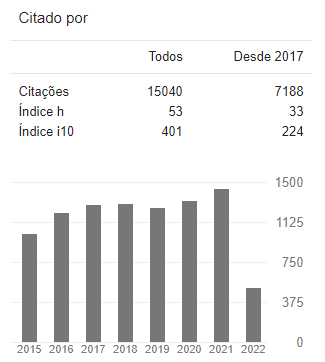Hypertrigliceridemic waist, physical activity and cardiovascular risk factors in schoolchildren
DOI:
https://doi.org/10.12820/rbafs.26e0199Palavras-chave:
Motor activity, Dyslipidemias, Blood glucoseResumo
The present study aimed to analyze the prevalence of the Hypertriglyceridemic Waist (HTW) and its rates with levels of physical activity, nutritional status and lipid profile of students from public schools. The 448 schoolchildren aged 10 to 18 years old were analyzed for body mass, height, BMI (waist circumference), triglycerides, total cholesterol, HDL-C, LDL-C, non-HDL cholesterol, fasting blood glucose and weekly physical activity time. The survey results showed a high prevalence of the HTW phenotype in schoolchildren (n = 125; 27.9%). The group diagnosed with phenotype has higher body mass, BMI, total cholesterol, LDL-C and non-HDL cholesterol and a lower level of HDL-C about the group without a diagnosis of the phenotype. However, for fasting blood glucose measurements and time of physical activity, the groups are no different. An association analysis using logistic regression showed the HTW phenotype associated with sex, nutritional status, and total cholesterol, where boys presented 2.0 (95%CI: 1.3 - 3.2); obese 6.2 (95%CI: 2.7 - 17.2) and cholesterol levels above 150 mg/dL 3.5 (95%CI: 2.1 - 5.7) times more likely to have the phenotype. In this way, the present research showed a high prevalence of HTW in schoolchildren from public schools, with boys, obese and schoolchildren with total cholesterol levels, the individuals most likely to have the phenotype. However, it is worth emphasizing the importance of monitoring these variables throughout the year in all courses, given the period of strong, biological, behavioral and psychological changes, as they can quickly change the values of the analyzed variables.
Downloads
Referências
Lemieux I, Pascot A, Couillard C, Lamarche B, Tchernof A, Alméras N, et al. Hypertriglyceridemic waist: A marker of the atherogenic metabolic triad (hyperinsulinemia; hyperapolipoprotein B; small, dense LDL) in men?. Circulation. 2000;102(2):179-84.
Costa PR, Assis AM, Cunha CM, Pereira EM, Jesus GD, Silva LE, et al. Hypertriglyceridemic waist phenotype and changes in the fasting glycemia and blood pressure in children and adolescents over one-year follow-up period. Arq Bras Cardiol. 2017;109:47-53
Silva DR, Werneck AO, Collings PJ, Fernandes RA, Barbosa DS, Ronque ERV et al. Physical activity maintenance and metabolic risk in adolescents. J Public Health (Oxf). 2018;40(3):493-500.
Thivel D, Masurier J, Baquet G, Timmons BW, Pereira B, Berthoin S, et al. High-intensity interval training in overweight and obese children and adolescents: systematic review and meta-analysis. J Sports Med Phys Fitness. 2019;59(2):310-24.
Buchan DS, Boddy LM, Despres JP, Grace FM, Sculthorpe N, Mahoney C, et al. Utility of the hypertriglyceridemic waist phenotype in the cardiometabolic risk assessment of youth stratified by body mass index. Pediatr Obes. 2016;11(4):292-8.
Guilherme FR, Molena-Fernandes CA, Hintze LJ, Fávero MT, Cuman RK, Rinaldi W. Hypertriglyceridemic waist and metabolic abnormalities in Brazilian schoolchildren PLoS One. 2014;9(11):1-5.
Conde WL, Monteiro CA. Body mass index cutoff points for evaluation of nutritional status in Brazilian children and adolescents. J Pediatr (Rio J). 2006;82(4):266-72.
Fernández JR, Redden DT, Pietrobelli A, Allison DB. Waist circumference percentiles in nationally representative samples of African-American, European-American, and Mexican-American children and adolescents. J Pediatr. 2004;145(4):439-44.
Esmaillzadeh A, Mirmiran P, Azizi F. Clustering of metabolic abnormalities in adolescents with the hypertriglyceridemic waist phenotype. Am J Clin Nutr. 2006;83(1):36-46.
Farias Júnior JC, Lopes AS, Mota J, Santos MP, Ribeiro JC, Hallal PC. Validade e reprodutibilidade de um questionário para medida de atividade física em adolescentes: uma adaptação do Self-Administered Physical Activity Checklist. Rev Bras Epidemiol. 2012;15(1):198-210.
Sallis JF, Strikmiller PK, Harsha DW, Feldman HA, Ehlinger S, Stone EJ, Williston J, et al. Validation of interviewer- and self-administered physical activity checklists for fifth grade students. Med Sci Sports Exerc. 1996;28(7):840-51.
Strong WB, Malina RM, Blimkie CJ, Daniels SR, Dishman RK, Gutin B, et al. Evidence based physical activity for school-age youth. J Pediatr. 2005;146(6):732-7.
Alavian SM, Motlagh ME, Ardalan G, Motaghian M, Davarpanah AH, Kelishadi R. Hypertriglyceridemic waist phenotype and associated lifestyle factors in a national population of youths: CASPIAN Study. J Trop Pediatr. 2008;54(3):169-77.
Barker AR, Gracia-Marco L, Ruiz JR, Castilho MJ, Aparicio-Ugarriza R, González-Gross M. et al. Physical activity, sedentary time, TV viewing, physical fitness and cardiovascular disease risk in adolescents: The HELENA study. Int J Cardiol. 2018;254:303-9.
Sun S, Zhang H, Kong Z, Shi Q, Tong TK, Nie J. Twelve weeks of low volume sprint interval training improves cardio-metabolic health outcomes in overweight females. J Sports Sci. 2019;37(11):1257-64.
Taylor JL, Holland DJ, Spathis JG, Beetham KS, Wisløff U, Keating SE, et al. Guidelines for the delivery and monitoring of high intensity interval training in clinical populations. Prog Cardiovasc Dis. 2019;62(2):140-6.
Osiński W, Kantanista A. Physical activity in the therapy of overweight and obesity in children and adolescents. Needs and recommendations for intervention programs. Dev Period Med. 2017;21(3):224-34.
Kumar S, Kelly AS. Review of Childhood Obesity: From Epidemiology, Etiology, and Comorbidities to Clinical Assessment and Treatment. Mayo Clin Proc. 2017;92(2):251-65.
Nuotio J, Pitkänen N, Magnussen CG, Buscot MJ, Venäläinen MS, Elo LL, et al. Prediction of Adult Dyslipidemia Using Genetic and Childhood Clinical Risk Factors: The Cardiovascular Risk in Young Finns Study. Circ Cardiovasc Genet. 2017;10(3):e001604.
Webber LS, Srinivasan SR, Wattigney WA, Berenson GS. Tracking of serum lipids and lipoproteins from childhood to adulthood. The Bogalusa Heart Study. Am J Epidemiol. 1991;133(9):884-99.
Li S, Chen W, Srinivasan SR, Bond MG, Tang R, Urbina EM, et al. Childhood cardiovascular risk factors and carotid vascular changes in adulthood: the Bogalusa Heart Study. JAMA. 2003;290(17):2271-6.
Daniels SR, Greer FR; Committee on Nutrition. Lipid screening and cardiovascular health in childhood. Pediatrics. 2008;122(1):198-208.
Lozano P, Henrikson NB, Morrison CC, Dunn J, Nguyen M, Blasi PR, et al. Lipid Screening in Childhood and Adolescence for Detection of Multifactorial Dyslipidemia: Evidence Report and Systematic Review for the US Preventive Services Task Force. JAMA. 2016;316(6):634-44.
Romualdo MC, de Nóbrega FJ, Escrivão MA. Insulin resistance in obese children and adolescents. J Pediatr (Rio J). 2014;90:600-7.
Kelishadi R, Jamshidi F, Qorbani M, Motlagh ME, Heshmat R, et al. Association of hypertriglyceridemic-waist phenotype with liver enzymes and cardiometabolic risk factors in adolescents: the CASPIAN-III study. J Pediatr (Rio J). 2016;92(5):512-20.
Chen S, Guo X, Dong S, Yu S, Chen Y, Zhang N, et al. Association between the hypertriglyceridemic waist phenotype and hyperuricemia: a cross-sectional study. Clin Rheumatol. 2017;36(5):1111-9.
Barreiro-Ribeiro F, Vasques AC, da Silva CC, Zambon MP, Rodrigues AM, Camilo DF, et al. Hypertriglyceridemic Waist Phenotype Indicates Insulin Resistance in Adolescents According to the Clamp Technique in the BRAMS Study. Child Obes. 2016;12(6):446-54.
Pereira PF, Faria FR, Faria ER, Hermsdorff HHM, Peluzio MCG, Franceschini SCC, et al. Indicadores antropométricos para identificar síndrome metabólica e fenótipo cintura hipertrigliceridêmica: uma comparação entre as três fases da adolescência. Rev Paul Pediatr. 2015;33(2):194-203.
Kuschnir MC, Bloch KV, Szklo M, Klein CH, Barufaldi LA, Abreu GA, et al. ERICA: prevalence of metabolic syndrome in Brazilian adolescents. Rev Saude Publica. 2016;50(Suppl):1-11.










